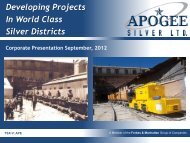Pulacayo Project Feasibility Study - Apogee Silver
Pulacayo Project Feasibility Study - Apogee Silver
Pulacayo Project Feasibility Study - Apogee Silver
Create successful ePaper yourself
Turn your PDF publications into a flip-book with our unique Google optimized e-Paper software.
<strong>Pulacayo</strong> 1 000 t/d Phase I <strong>Feasibility</strong> <strong>Study</strong> - NI 43-101 Technical Report<br />
090644-3-0000-20-IFI-100<br />
Once the mining concession has been obtained, the title holder is able to explore and exploit<br />
the minerals within the mining concession including tailings and residual material. To retain<br />
the rights to the concession, the title holder must maintain the concession in good standing<br />
through the annual “patentes” payment, the cost of the “patentes” per “cuadrícula” being<br />
about USD 40.00 per year (USD 80.00 if the concession has more than five years). If the title<br />
holder continues to make the “patentes” payment on time, the mining concession is<br />
indefinite, according to current legislation.<br />
“Cuadrícula” is the mining measure unit, which is an inverted pyramid with the inferior vertex<br />
pointing to the earth’s core, with an exterior perimeter equal to 25 hectares. Some existing<br />
mining concessions have been applied for and granted according to the system governed by<br />
the old Mining Code, which has not been in effect since 1997. However, the concessions are<br />
totally legal. The measure unit of the mining concessions obtained according to the old<br />
Mining Code system is the “pertenencia minera”, which is an inverted pyramid with the<br />
inferior vertex pointing to the earth’s core, with an exterior perimeter equal to one hectare.<br />
Mining concessions cannot be transferred, sold or mortgaged. Joint Venture agreements are<br />
permitted.<br />
The Bolivian Constitution passed and enacted in February 2009, on its article eighth section<br />
3, of the Transitory Provisions Chapter, establishes that all the mining concessions must be<br />
adapted to the new constitutional regime and then must be converted to “mining contracts” in<br />
a term of one year from December 6th 2009.<br />
Since 06 December 2010, a new Mining Law compliant with the Constitution enacted in<br />
February 2009 was not in effect, the Bolivian government issued the Supreme Decree No.<br />
726/2010. The mentioned Decree on its first article establishes that all the mining<br />
concessions (while the new Mining Law is being prepared and then enacted) will have the<br />
category of “Autorizaciones Transitorias Especiales” or Special Transitory Authorizations.<br />
The second article of the Supreme Decree No. 726/2010 also establishes that the preestablished<br />
rights of the Special Transitory Authorizations are guaranteed.<br />
The Codigo de Mineria (1997) is available in an official Spanish-English side-by-side version,<br />
which facilitates understanding the Bolivian mining code. Key features are:<br />
<br />
<br />
<br />
<br />
<br />
<br />
There is only one type of mining license, a “La Concesion Minera” (currently<br />
known as “Special Transitory Authorization STA”), which is comprised of 25 ha<br />
units, named “cuadricula minera”. A maximum of 2,500 units is allowed for a<br />
mining concession.<br />
There is no limitation to the number of concessions that can be held by a<br />
company or an individual.<br />
Field staking is not required; concessions are applied for on 1:50 000 scale base<br />
maps.<br />
The concessionaire has exclusive rights to all minerals within the STA.<br />
If the title holder continues to make the “patentes” payment on time the term of<br />
the mining concession is indefinite.<br />
Mining concessions cannot be transferred, sold or mortgaged.<br />
TWP Sudamérica S.A. Av. Encalada 1257 Of. 801, Santiago de Surco Lima 33, Perú (51-1) 4377473<br />
Page 20



